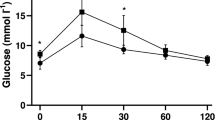Summary
The effects of changes in oxygen supply and oxygen demands on fiber cross-sectional areas, capillary dersities and capillary to fiber ratios were determined in three skeletal muscles of rat. The muscles examined were the vastus lateralis, soleus, and diaphragm. Reduced oxygen supply was produced by subjecting rats to ambient hypoxia, and increased oxygen demands were produced by subjecting rats to low ambient temperatures or treatment with thyroxin. Capillaries were visualized by injecting fluorescent dyes into the circulation. Muscles were quick frozen at resting lengths to preserve normal fiber geometry and were subsequently sectioned on a cryostat. All of the muscles sampled from animals in the experimental groups had elevated capillary densities. However, capillary to fiber ratios were not increased significantly in any muscle, for any experimental condition. Thus, all of the observed differences in capillarity were due to changes in the intrinsic rate of muscle fiber growth. Further, the relations of capillary density and capillary to fiber ratio to fiber area were the same as those obtained during normal maturation, suggesting that capillary growth is closely linked to the intrinsic rate of fiber growth.
Similar content being viewed by others
References
Ballantyne JS, George JC (1978) An ultrastructural and histological analysis of the effects of cold acclimation on vertebrate skeletal muscle. J Therm Biol 3:109–116
Banchero N (1987) Cardiovascular responses to chronic hypoxia. Annu Rev Physiol 49:465–476
Banchero N, Kayar SR, Lechner AJ (1985) Increased capillarity in skeletal muscle of growing guinea pigs acclimated to cold and hypoxia. Respir Physiol 62:245–255
Boutellier U, Howald H, di Prampero PE, Giezendanner D, Cerretelli P (1983) Human muscle adaptations to chronic hypoxia. Prog Clin Biol Res 136:273–281
Boyer SJ, Blume FD (1984) Weight loss and changes in body composition at high altitude. J Appl Physiol 57:1580–1585
Capo LA, Sillau AH (1983) The effect of hyperthyroidism on capillarity and oxidative capacity in rat soleus and gastrocnemius muscles. J Physiol (Lond) 342:1–14
Depocas F, Hart JS (1957) Use of the Pauling oxygen analyzer for measurements of oxygen consumption in open-circuit systems and in short-lag, closed-circuit apparatus. J Appl Physiol 10:388–392
Freyschuss B, Eriksson H (1988) Evidence for a direct effect of thyroid hormones on the hepatic synthesis of estrogen receptors in the rat. J Steroid Biochem 31:247–250
Hargreaves D, Egginton S, Hudlicka O (1990) Changes in capillary perfusion induced by different patterns of activity in rat skeletal muscle. Microvasc Res 40:14–28
Heroux O, St. Pierre J (1957) Effect of cold acclimation on vascularization of ears, heart, liver, and muscles of white rats. Am J Physiol 188:163–168
Hoppeler H, Kleinert E, Schlegel C, Claasen H, Howald H, Kayar SR, Cerretelli P (1990) Morphological adaptations of human skeletal muscle to chronic hypoxia. Int J Sports Med 11:S10-S14
Hudlicka O (1984) Development of microcirculation: capillary growth and adaptation. In: Renkin EM, Michel CC (eds) Handbook of physiology, part 1. The cardiovascular system. Microcirculation. Am Physiol Soc, Bethesda, Md., pp 165–216
Hudlicka O (1985) Development and adaptability of microvasculature in skeletal muscle. J Exp Biol 115:215–228
Hudlicka O, Price S (1990) The role of blood flow and/or muscle hypoxia in capillary growth in chronically stimulated fast muscles. Pflügers Arch 417:67–72
Ishihara A, Inoue N, Katsuta S (1991) The relationship of voluntary running to fibre type composition, fibre area and capillary supply in rat soleus and plantaris muscles. Eur J Appl Physiol 62:211–215
Mathieu-Costello O (1987) Capillary tortuosity and degree of contraction or extension of skeletal muscles. Microvasc Res 33:98–117
Mathieu-Costello O (1989) Muscle capillary tortuosity in mice native to high altitude depends on sarcomere length. Respir Physiol 76:289–302
Poole DC, Mathieu-Costello O (1989) Skeletal muscle capillary geometry: adaptation to chronic hypoxia. Respir Physiol 77:21–29
Pugh LGCE (1964) Animals in high altitudes: man above 5000 meters — mountain exploration. In: Dill DB (ed) Handbook of physiology, section 4. Adaptation to the environment. Am Physiol Soc, Bethesda, Md., pp 861–868
Ripoll E, Sillau AH, Banchero N (1979) Changes in the capillarity of skeletal muscle in the growing rat. Pflügers Arch 380:153–158
Sillau AH, Banchero N (1977) Effects of hypoxia on capillary density and fiber composition in rat skeletal muscle. Pflügers Arch 370:227–232
Sillau AH, Aquin L, Lechner AJ, Bui MV, Banchero N (1980) Increased capillary supply in skeletal muscle of guinea pigs acclimated to cold. Respir Physiol 42:233–245
Snyder GK (1987) Muscle capillarity in chicks following hypoxia. Comp Biochem Physiol [A] 87:859–861
Snyder GK (1988) Model analyses of capillary growth and tissue oxygenation during hypoxia. J Appl Physiol 65:2332–2336
Snyder GK (1990) Capillarity and diffusion distances in skeletal muscle. J Comp Physiol [B] 160:583–591
Snyder GK, Coelho JR (1989) Microvascular development in chick anterior latissimus dorsi following hypertrophy. J Anat 156:97–106
Snyder GK, Wilcox EE, Burnham EW (1985) Effects of hypoxia on muscle capillarity in rats. Respir Physiol 62:135–140
Snyder GK, Gannon B, Baudinette RV (1989) Functional organization of cerebral microvasculature in a marsupial, the Northern Quoll (Dasyurus hallucatus). J Exp Zool 251:349–354
Wickler SJ (1981) Capillary supply of skeletal muscles from acclimatized white-footed mice,Peromyscus. Am J Physiol 241:R357-R361
Withers PC (1977) Measurements of\(\dot V\) O 2,\(\dot V\) CO 2, and evaporative water loss with a flowthrough mask. J Appl Physiol 42:120–123
Author information
Authors and Affiliations
Rights and permissions
About this article
Cite this article
Snyder, G.K., Farrelly, C. & Coelho, J.R. Adaptations in skeletal muscle capillarity following changes in oxygen supply and changes in oxygen demands. Europ. J. Appl. Physiol. 65, 158–163 (1992). https://doi.org/10.1007/BF00705074
Accepted:
Issue Date:
DOI: https://doi.org/10.1007/BF00705074




